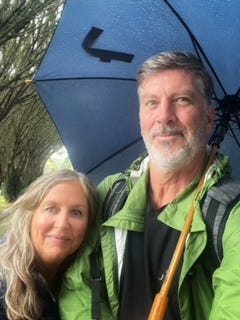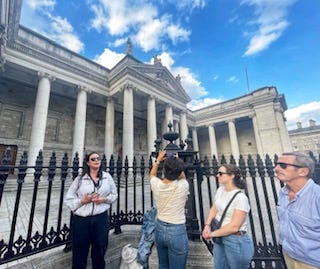A few weeks ago, we sold our house in the Canadian Rockies and went out to see what home might be like on the road. We chose to arrive in Dublin. Aer Lingus had an inexpensive flight offer from Seattle. And I’d been fascinated by the cultural expressions of this tóg go bog é1 kind of place when, years before, I was invited to read at a literary festival in Bantry, West Cork.
My partner, Richard, and I both have ancestors from Ireland, mine a great-grandfather Tommy Moran who was born on Christmas Day in County Mayo and then made himself a stowaway to America during the second famine of 1861.2 The Irish imagination has taken up a significant place in my family lore, and in the works that I read, including the Irish women Eavan Boland, Anne Enright, Tana French, Sally Hayden, Edna O’Brien, and Sally Rooney. My partner hadn’t been to Ireland yet and loved theatre, and since Dublin was hosting the Fringe Festival beginning the weekend that we planned to arrive, we made a plan to enter that city along the River Liffey.
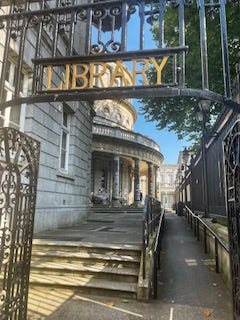
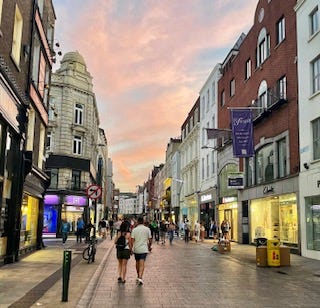
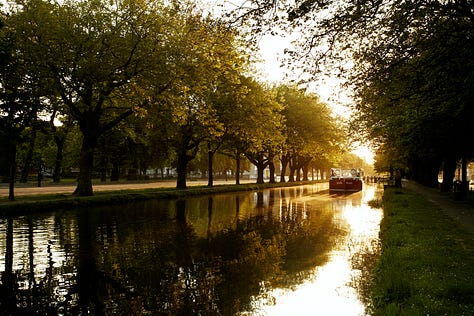
We are traveling while also living a relatively ordinary life. It’s not exactly like a vacation where you run around seeing things, and in today’s mode, proving that you’re having a very excellent time by posting about it on social media. It’s also not been the same thing as showing up to work, something I’ve done regularly since I was twelve. Since we decided to surrender most of our obligations and commitments, more of our former schedule is suspended. On the street, in restaurants and lobbies, I meet people who are rewarding themselves with time away from the grind. I’m aware that I’m neither fully working nor relaxing, but inside my labor alongside plenty of rest and wandering.
No doubt, I am pleasing myself. I no longer believe in the duty embedded in the need to prove one’s worth. We don’t have to deserve what the Irish call the craic, the fun. Deserve—a word that comes from the 12th century from the Latin deservire, to "serve well," and has its roots in obedience, duty, compliance, and servitude—is eliminated from my vocabulary. Still, I’m serving my work and all that I love on the road. I’m being purposeful in the journey, imagining another kind of existence, completing research on this novel I’ve been engaged with for eight years now, writing new work, editing two books, visiting family, seeing art, and thinking about what it’s like to live as an artist. This wandering is a luxury, one that I’ve never taken the time to do since I began to work half a century ago. I left home at seventeen, paid for my college education, got married, had babies, got sober, took care of an ill partner, and became ill myself. Healing and repair take time and space. The old life is going to be left behind, and the new one has to be met, no matter if you are awake to it, or not.
We’re aware of having the privilege to strike out on an adventure, to stay in apartments and inns, to have people clean our room and make our food. The experiences in the places we have chosen are not more expensive than our payments for our former home and groceries, but this adventure is still extravagant in its ability to leave an established work routine and responsibilities. We think of the benefit of travel every day and are grateful for everything we’ve been offered, repaying those with whom we’re engaged with gratuities and kindness. We are aware that we are tourists, and that we must ally with the residents of the communities we visit. A harsh form of capitalism exists inside tourism, one that denies travel to those displaced by extractivism and war, one that can spread social inequality by benefiting corporate owners rather than working toward justice for local people. In all forms of travel and leisure, we might be embedded in an exchange that causes problems for the residents of that region, including the use of rentals like AirBNB for tourists when homes are needed for workers. We are choosing to travel in the off-season to avoid stressful times for workers, and are committing to local stays and restaurants, and are listening to how we might take up space to avoid becoming a burden to the people who call this place home. Decolonizing travel will mean that we move differently over the lands outside our homes, near or far. Restructuring travel toward justice is complex. I’m still thinking about these issues.
It's also uncomfortable in new spaces. There are infringements of noises we didn’t expect, routines we didn’t make, food we don’t prefer, territory that can seem dangerous, words that can be inspirations or assaults. I’d been in a taxi for five minutes one day when the driver declared his expertise in his religion and began speaking about my womb and his faith’s beliefs for it. (I’m not looking at you solely, Dublin. This exchange could happen in my home state of Kentucky.)
There are moments when I’m aware that I’m traveling after having lived for seven years in the relative isolation of a small town and wilderness. Though my transition to the busy urban life in Dublin was significant, it was a similar shift as the one I’ve been making several times each year in travel between Banff and Seattle.
Dublin was a place of singing erupting out of pubs, of boys carrying their hurling gear off the DART, of humans with their arms wrapped around each other on the street, of footy matches that overflowed the stadium. Like Alberta, the province that I’d moved from, Dublin had an edge of toxic masculinity. These places both have centered a high value on heroic storytelling, sports culture, traditional family roles, and gender essentialism. Both places are known to have inadequate mental health support3 and are slow to recognize ableism. Their bar and pub scenes can appear culturally distinct, but you can still tell that bodies are being damaged by centering alcohol as a stand-in for joy.4
There are times that a culture feels intimate because it lives just as it does in your mind’s eye, and other times it’s familiar precisely because of its particular cruelties.
Whatever was happening, we wanted to believe that we were up for it. We wanted to look for not just what was going on in the obvious places, but to see what might be lurking in the underneath. As the Irish proverb says—it’s in the shelter of each other that the people live.
As I wrote about here and here, my intention in this four-month wander is to connect with land and art. Here are a few experiences below that challenged and shaped us during our week in Dublin.
For everyone, there are insights and experiences from the road. For paid subscribers, there are food experiences and restaurants we tried including the spectacular Ginger Man Pub, and the steak house Hawksmoor, coastal chowders, extraordinary breakfast feasts, as well as a few recipes to bring the feel of Ireland home to you.
Éirinn go Brách,
Sonya
A Dublin Guesthouse
We stayed at Ariel House in what our driver from the airport called the D4, classy with all the embassies. Jennie McKeown is the local proprietor, a hospitality management graduate who went to work at London’s Claridge’s and then returned home to become the owner of this Ballsbridge inn. Three Victorian townhouses make up the inn, and for about $150/night we received a breakfast that lasted us all day, afternoon tea in the conservatory, and wonderful hospitality. The guesthouse is removed from Temple Bar and the tourist scene, which meant we often walked kilometers home each evening, but that was mostly a benefit for us.
Breakfast was a sideboard of granola, yogurt, oats, freshly baked bread, scones, muffins, and other pastries, homemade jams and preserves, fresh fruit, a gorgeous cheese tray, juices, coffees, and teas, alongside a selection of made-to-order items like the traditional Irish breakfast, pancakes and smoked salmon, served in a lovely conservatory. Amazing.
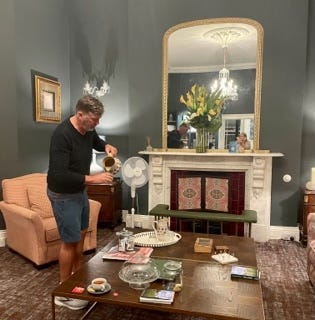
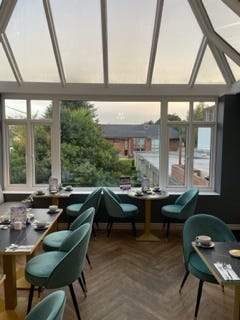
Dublin Fringe Fest
We bought tickets for the festival as soon as our flights were booked. One event a night for five nights, in venues throughout the city, including its arts centers, black box theatres, and the National Botanic Garden. Each of us picked shows we were intrigued by. Every show that we attended appeared to be sold out. Tickets were about 10-16 Euros/$11-17 US.
Highlight: Hothouse One of the most extraordinary plays I’ve seen in years. Kind of a cabaret on the climate crisis, but also with an emotional center, a character tale, and macabre humour. The choreography and staging are exceptional. Written by Carys D Coburn with the company. Read more about the deadly serious and wildly funny story in the Irish Times.
The moment: When the narrator takes an emotional turn into the nihilism of the future, the audience’s hackles rise. Glorious to see the intimate twists that make us reckon with our despair, but don’t leave us there.
Opening Night: Who doesn’t love a Devil and Daniel Webster provocation? Endings, on love, loss, and contemporary masculinity included a virtuoso performance by actor-writer Fionntán Larney, interviewed here, and who we also noticed in the audience at other shows, supporting the theatre community.
Tip: Get to the venues early, especially if you’re taking a taxi, as transport in the city can surge after work, like in any other urban center.
Tours
We walked about 10 km a day, mostly finding our way around the city ourselves, but two tours were powerful and fascinating, nearly reshaping my views on the sustaining images of myths and the ferocity necessary for real activism.
Mythology & Folklore Walking Tour – We booked with the wise and wisecracking Emily, who led us into stories about the leprechaun, banshee, and púca, and wove the ancient history of Eire and its cultures. The Get Your Guide app is easy to use for booking in many cities.
Tour of Ireland’s National Cemetery at Glasnevin – We learned about the lives and legacies of Charles Stewart Parnell, Daniel O’Connell, Éamon de Valera, Countess Markievicz, Maud Gonne, and Michael Collins in this brilliant tour of the cemetery at Glasnevin. The historian leading this tour evoked not just facts but what it would have been like to live through different periods of Irish history, including the rebellion, the 1916 Rising, and the War of Independence. With stories of women snipers, bustles that could hide bombs, and funerals as cultural events, I was reminded of the rigors of social justice, and especially of the women who advanced the cause.
Don’t forget about going to the Gravedigger’s Pub just off the grounds. Even Anthony Bourdain visited here, and it’s said that of the 1.6 million burials at Glasnevin, quite a few of the wakes happened here.
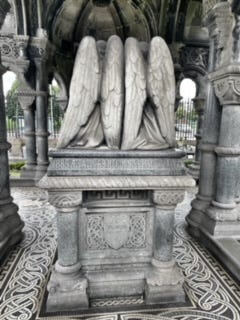
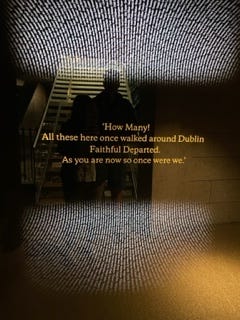
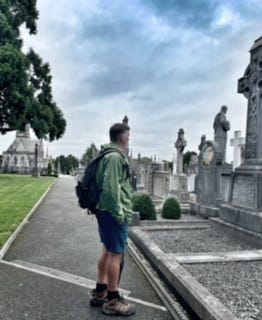
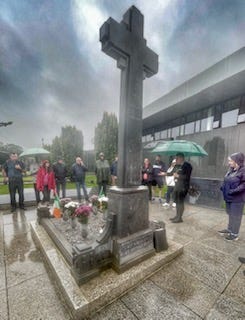

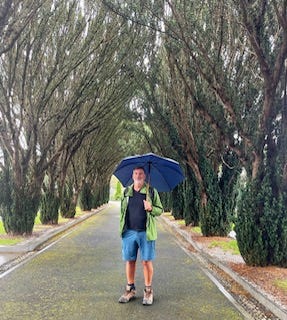
A Hike at the Sea
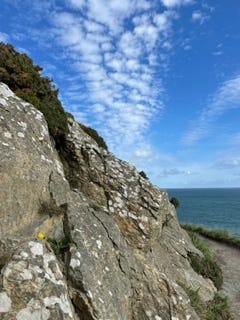
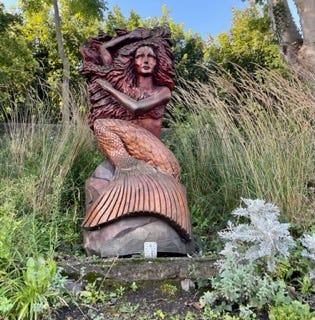
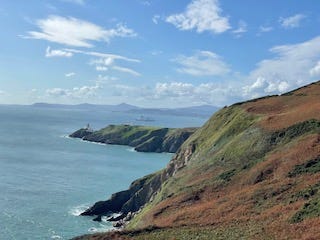
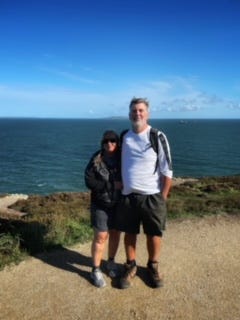
Thank goodness we listened to the folks at our guesthouse and took the DART train out of the city for a day. It’s about forty minutes to Howth, where the walk begins, and then continues along a gorgeous sea cliff anywhere from six to twelve kilometers, depending upon your route. There was a food truck and toilets at the top by the lighthouse, and you can’t go wrong with tea time or supper in the lovely town.
I had just finished reading Sarah Polley’s essay collection, Run Towards The Danger, and had asked Richard to read it, starting with the title essay. I mostly remember how clear we felt after that hike, how the wind and the water had lifted the ache of travel from our bodies, how we sat with cups of tea looking out toward the blue of Dublin Bay, how I’d turned and watched him cry as he read a passage about her recovery. If you’ve had a concussion or brain injury, or been with someone who has, Polley writes breathtakingly specifically about the trauma and its aftereffects. The book is also a brilliant way of thinking about memory, and its waves of mutability, the arc toward realizing the past and the present reality, and the potential path out of harm being to run toward the activities that might trigger us.
Museums
The National Gallery – The national museums in Ireland are all free, and definitely worth a visit. My favorite exhibit at the National Gallery was It Took a Century: Women Artists and the RHA, a 100-year historical survey of the art academy developed by artists, an institution late to accept women. They have a lovely cool and modern café.
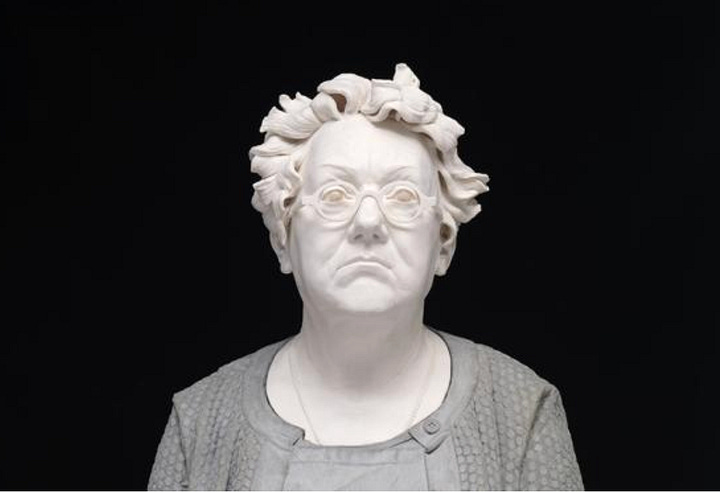
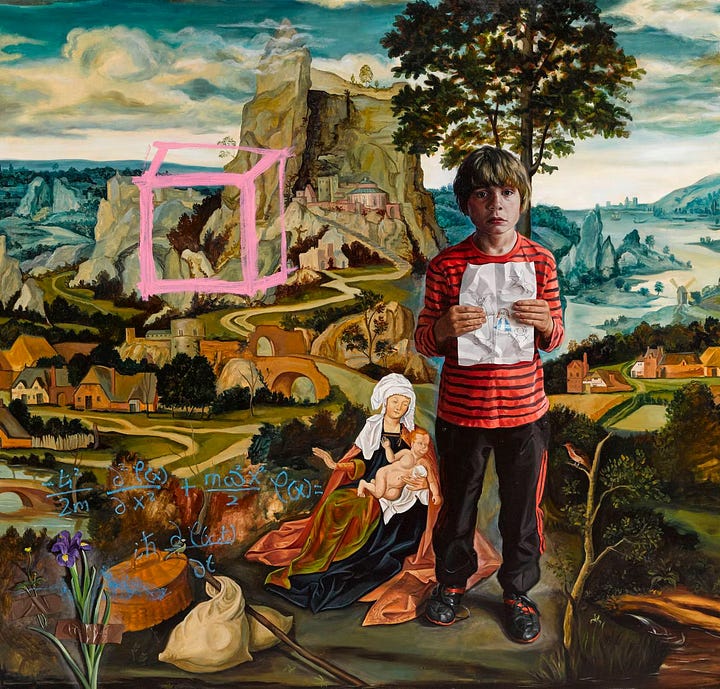
Museum of Literature Ireland (MoLI) – As a former museum staffer, I found the exhibits here disappointing. They’re mostly made to read, with little interaction, shoddy design in some cases, and some of the panels are in need of repair. Still, if you want to track the timeline and associations of James Joyce’s Dublin, and hear contemporary authors like Claire-Louise Bennett’s Nightflowers, it’s worth a visit. Note that the museum is not free. The grounds offer a lovely visit to literary history, including the giant ash tree that Joyce was photographed leaning against. It was beautiful to walk outside to the garden and hear writers talking about how COVID had shaped their work. The café The Commons serves up classics like toasties, fruit scones, homemade soups, and substantial pots of tea, as well as items like vegan curry and flourless raspberry bakewell.
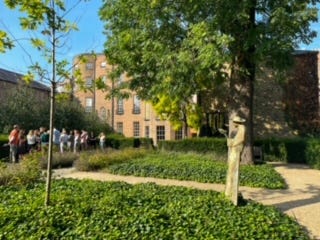
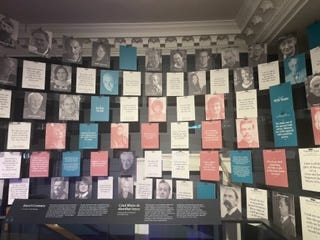
Sports
Ariel House is next door to Aviva Stadium, where Ireland played the Netherlands to a massive crowd in September. We left for our 630 pm theatre showtime early enough to sit outside the Irish Times to chat when we noticed the chanting of thousands of men coming in our direction. I ran around the corner and got lost in a parade of them, a wave of footy madness snaking toward the event and singing fight songs.
After the theatre curtain closed that night, on the walk home toward the stadium, we saw groups of guys running from the streets to the stands. I looked toward a garda on duty, watching the match on his phone. “They’re playing good for a change!” he shouted. We set up the game on our TV and opened the window to the stadium where we had the best seats for their cheers, groans, and commentary. If you’re a sports fan, you’ll find at least a day’s worth of joy in grabbing tickets to an Irish football match. Tickets from 50E.
Parks
Dublin was unseasonably hot and sunny when we were there in September, and the city’s parks were stunningly gorgeous. We laid about in St. Stephen’s Green, The National Botanic Gardens (while listening to an evening of sound art,) and wandered the gardens of MoLI. There’s a little secret garden called Iveagh Gardens just behind that Museum too. We saw groups of people picnicking, reading, sleeping, playing. Maybe one of my favorite things about our stay was being with people in pubs and public gardens.

Transport
Do use the app FreeNow to book a taxi in the city, but don’t use this app to book your ride to or from the airport. The drivers will receive more payment from a direct booking for those longer hauls. Note that the drivers have a strong union in the city, so cars from Uber, etc., end up reverting to the regular taxi service. Just walk to taxi line-up at the airport and you’re on your way.
The DART is a fabulous service, cheap and easy to use. Take a look at a map before you go to see if you can use the transport in or out of the city.
After Ireland
I’ll see you next time from Ikaria, Greece, an island in the north Aegean Sea off the coast of Athens, near Turkey, who they expelled to achieve independence in the Ikarian revolution of 1912. Ἰκαρία has been inhabited since 7000 BC and is known for being the island where people forget to die.
Come along on the journey with me to Ikaria, Puglia, Sardegna, London, and the south of France.
More of Eire
Check out events at the Irish Museum of Modern Art, The National Concert Hall, the live music theatre, The Sugar Club, readings and events at The National Library (I learned about this remarkable institution too late to book anything,) and events at the Chester Beatty, a delightful museum I visited on a previous trip.
The Dublin Book Festival is in November if you fancy a quick trip.
Discover this self-guided foodie tour of Ireland, from the wonderful chefs at the Kitchn here.
More From Sonya
Writers and readers have been asking me about the essay I wrote after my mother’s death, and about connections to familial impositions of the patriarchy, “The Ghost World of Women.” Originally this essay was published in that fabulous literary journal, Entropy, and since that archive is no more, I have posted the piece on my website here.
And now, The Irish Food
Eating Around Dublin
Lots of people think the UK in general is nondescript in its restaurant choices, and if you end up hanging out only in the touristy Temple Bar area of Dublin, you might be right. But we found some incredible choices, and mostly ate simply, and late at night. on the walk home from the Fringe. The recipes below are similar to what I tasted in Dublin unless noted. These are for paid subscribers, so if you’d like a taste of travel brought to your home, subscribe to Wanderland. If you don’t have the funds right now, but you want to continue to read and support this newsletter, I’m happy to send you a gift subscription. Please contact me from my website.
In the next newsletter for paid subscribers, there will be more food and meals made on the road from our seventeen days on the Ikarian land and sea
Ginger Man Pub’s Guinness Pie
The Ginger Man is a stone’s throw from Trinity College and fills quickly on game days. Our drivers called it the priciest pint in town, but I don’t imbibe, and my partner barely finishes one, so we went in for the steak and Guinness pie, which was sublime, and came with a side of mash you could drizzle that dark gravy all over.
I’ll try making this at home, perhaps with a recipe like this one, only adding carrots and possibly little pieces of turnip if I can get away with it. If I were doing this vegetarian, I’d add lots of mushrooms, carrots, onions, celery, and a rich thyme-flavored stock like this one.
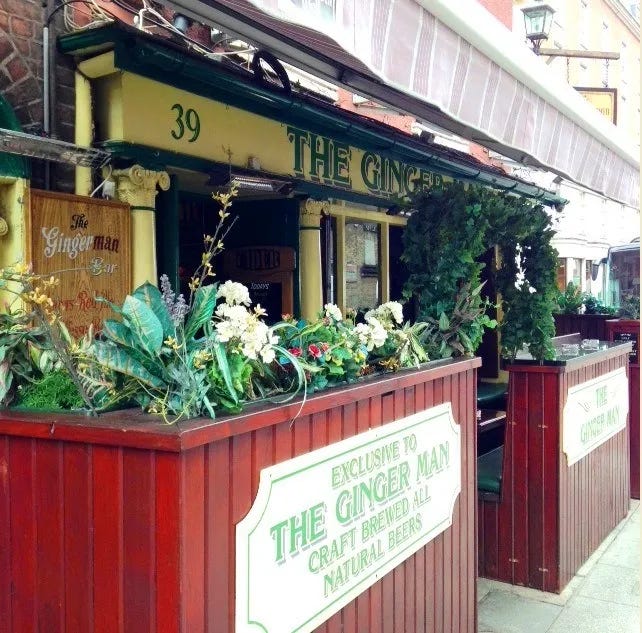
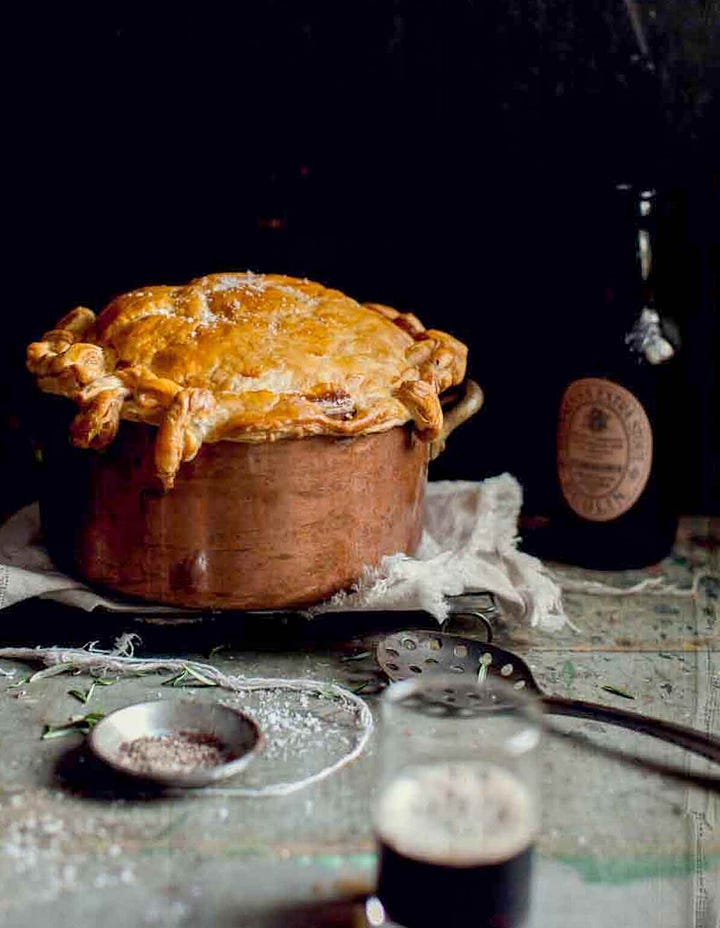
Keep reading with a 7-day free trial
Subscribe to Wanderland to keep reading this post and get 7 days of free access to the full post archives.




